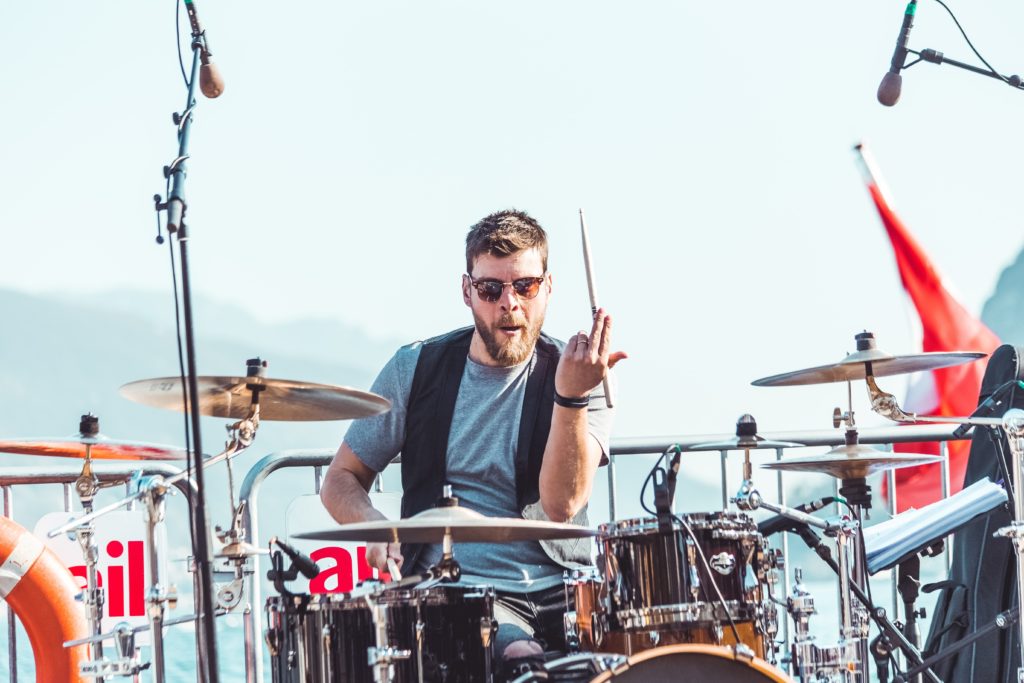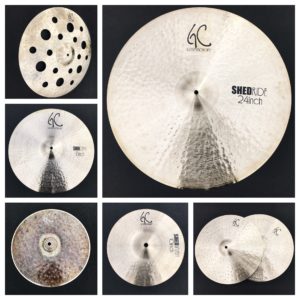Recording Drums

If you ask 100 drummers how they record their drum tracks, you’ll likely get 100 different answers. But if you ask recording engineers about the best recording techniques for drums, you’ll quickly notice that they limit their recording techniques to a few trusted methods that have been proven best over time.
The evolution of drums has greatly boosted the quality of music. However, it has also made recording drums challenging as you will need some level of skill in both drumming and recording to get it right. This article will teach you all you need to know about how to record drums for that unbeatable sound of real drums.
You will understand:
- How to record drums with one mic
- How to record drums with two mics
- How to record drums with three mics
- How to record drums with unlimited mics (best mic setup)
- How to mix drum recordings in a DAW

Preparing the Room for Recording
From crashing cymbals to booming floor toms, drum sets generate a huge amount of sound waves. These waves can complicate a recording session when those waves are bouncing around the room. So the purpose of acoustic treatments for drum recording should be to control those waves so that you don’t record an echo.
Popular techniques include everything from expensive studio foam and sound dispensers to cheap blankets. We won’t go deep into it here, but remember that echo is reduced when reflective material is covered. So check your recording space and cover reflective material with something that will absorb sound waves.
How to Record Drums with One Mic
The overall sound captured while recording drums is highly associated with the distance of the microphone from the drums. The following is the best way to set up your single microphone for recording a complete drum set. While recording a single mic drum set, you have to start with a close acoustic balance of the drums themselves. If the hit hat sound is too much in the mix, you have to adjust the position of the mic to capture a more complete sound.
For a dead unsustainable tune, it is advisable that you check the tuning of your drums and general condition. Most of the time it is not a matter of a malfunctioning microphone that is stopping you from getting top-quality sound. It may be a problem that can be solved by a fine adjustment on the dynamics of your drums.
Position 1: Far Room Mic
Where exactly do I place my microphone? For a single-person project that needs a natural presentation of instruments, you may find placing your microphone ten inches in front of the drum set is an appropriate setup. You have to ensure that your microphone is pointing directly towards the central part of the kit. When the recording is played back through headphones, this position yields a good representation of the overall performance of the kit.
This setting is not preferred in a setting where precise tones of the drums are needed and where the tones are required to be very clean. Avoid this set up if you are intending to play fast blast beats.
Position 2: Near Room Mic
Another distance that you may find appropriate to position your mic is placing it five inches from the middle of the kit. This position yields a balanced representation for your kit. You will get a more defined sound. In comparison to the far room positioning, this setting will get you a slightly fuller sound whose lower frequencies are well pronounced. Try this setup if you will not be playing heavily on the toms.
Most professional drummers will tell you that low-frequency beats are tricky to get into a microphone. This is associated with how efficient both moderate and increased frequencies traverse through the open air. With a single mic at a close distance, you can retain a good balance. But as you move away from the kit, you will notice its tone thins with every inch.
The Third Position is the Mono Overhead
This setup allows you to capture the recording while positioning the mic directly over the batter head of the bass drum, approximately 12 inches above the drummer’s head. In this setup, you will find the microphone ends up capturing the entire drum kit. For a very huge set of drums, you may be forced to raise the microphone to allow it to record sound waves from the whole set.
Normally, this position allows for gathering a compound sound that can easily be incorporated with sounds from other instruments. The only drawback is that the bass of the drums tends to fade out.
These are the most used single-mic positions for your microphone.
Absolute Zero Phase Issues
Are you aware that any moment you involve more than one microphone in capturing your drums, you stand a high chance of experiencing phase issues? Okay, worry no more, with single mic recording you will get absolutely no phase issues.
When you apply multiple microphones in recording your drums, you may risk capturing thinned out sound due to phase issues. This sound is the product that remains after a chunk of sound waves have been canceled out. Well, when you use only one mic, you will experience absolutely no phase cancellation.
Single mic recording also delivers an instant punchy sound. This is associated with the above reason. What we hear in the recording room can be canceled with increased mic count. If you use only one mic, you are bound to yield a punchy sound, which is the intended natural sound of the drums.
It is also easier for you to get a realistic sound balance when using only one microphone. While using a considerable number of mics you are bound to experience difficulties in identifying the right balance for your kit. While using only one mic, your work is pretty simple. Single-mic setups generally give you much room to adjust your mic to suit your needs.
While using one mic, you may find it super-fast to mix. This time saving emerges from the zero time spent in fixing phase issues and also only one drum mic is to be processed.
Next, let’s look at how to position two mics while recording drum sets.
How To Record Drums With Two Mics
Many professional sound engineers have been seen miking drums with over ten or so microphones depending on the number of drums they have in their kit. They may use spot microphones that are positioned to a particular drum to allow it to pick up either a kick, tom, or snare without it bleeding out from the rest of the setup.
Application of the overhead microphones is aimed at capturing the entire set of drums at the same time. Typically, they are placed above the drum set. And lastly, there may be room microphones which may either be a mono mic or stereo pair, or both. These are usually placed on the backside of the kit. To capture the ambient sound the drums make while interacting with the acoustics of the room, room mics are usually used to introduce space in drum sounds while mixing.
An important thing to note is that all of these different types of microphones are recorded on their own independent tracks. Later on, a sound engineer, will combine them and apply it in the creation of a balanced and exciting drum sound. If no particular retro effect is wanted, the drum kits often are mixed in stereo mode.
Overhead and Kick
You may be wondering how this double miking is done. First, this setup features one mic placed as overhead to capture the overall sound from the kit, and then the second one is placed as a spot microphone near the kick drum. This type of configuration results in enhanced control over the sound and level of the kick while mixing. It also allows a considerable balance of the whole kit as you carefully position your overhead mic. The only drawback you may experience is that this design will limit you to a mono drum mix.
To capture a snappy kick sound, you will be required to position the drum mic near the front head of the bass drum or move it a bit inside. You will notice, the closer the mic moves to the back head, the more snappy kicks you are bound to get. For the overhead mic, it’s best to use a condenser microphone since it will allow you to capture a crisper reproduction of high frequencies. With different variations in the height positioning of the overhead mic, you will surely discover the sound of your liking.
Pairing Up
A second choice for miking your kit with two mics is to apply two overhead mics in a stereo mode and recording the mics on separate tracks. The extent of coverage of the drum set will depend on the type and size you have chosen for your music. Smaller kits will receive broader coverage, while bigger kits will receive less.
This mic set up allows the producer to spread mics on either part of the drum set. The choice of placement depends on which position produces a better sound balance and brings a better overall picture of the setup of the kit. A major setback you may experience is that this setup, despite offering a wide stereo image, will give you phase issues that result in cancellation of the sound if heard over a mono output. With this problem in mind, engineers have developed the following stereo miking configurations:
1. Blumlein
2. ORTF
3. M/S and XY
These configurations require a specified mic placement while relating to each other. I would advise using a matched pair of the same mics for the above applications just to allow the matching of the right and left stereo soundtracks.
Lastly, the best stereo drum miking configuration of choice is called the “Recorderman” method. It entails the use of two microphones, where one is placed over the snare and another over the shoulder of the person hitting the drums. Distance measurements should be done between the snare and the kick. If done well, it will yield a soothing stereo that is has been appropriately balanced.
How to Record Drums with Three Mics
An example of this set up is placing one microphone directly over the kit, which can be approximately forty inches high and allow it to directly face the snare drum. Place the second microphone at the three o’clock position to the floor tom. These can be about one to three feet above the rim of the tom and approximately forty inches ways from the snare drum. These two microphones will be used as the overhead mics. Their purpose is to get a better balance of the full drum set since they will be used to capture the sound of the main drums.
You will have to put the last microphone near the kick drum. Its use is to fill the kick drum so that it is punchier in the drum mix. If this is not done, the kick drum will tend to get lost in the mix. You should give the two overhead microphones more attention since they form the bigger part of the recording by contributing the primary sound. Ensure that they are equidistant from the snare drum, this is to allow a proper phase creating a more quality sound output.
What factors play a role in the recording of sound in using this method?
- Your experience as a drummer – ensure a proper balance throughout the performance
- The kind of space you have for drum recording

How to Record Drums with Unlimited Mics (Best Mic Setup)
Different engineers tend to have different techniques of recording sound that they have gathered over their years of practice. Looking across all of them, you will find the following set up is mostly used.
You should always ensure that the drums are always well-tuned any time before recording. If you have many microphones ensure they are of different diaphragms. The sensitivity of the condenser microphones renders them ideal in capturing a larger range of frequencies.
What are the techniques involved?
There are two main techniques involved, the most applied one is the A/B method. It involves two mics put to the right and left sides of the kick. This allows you to capture more of the room sounds with a widened stereo image. The second image is the X/Y technique, which is accompanied by lesser phasing issues since the capsules are near each other. It also leaves limited control of balance and images of the individual parts of the kit. To be able to capture the weight of the kick drum, apply a kick drum mic to help boost the bass of the recording. A condenser or dynamic mic can be used to put emphasis on the snare of the recording.
Consider close miking is the most flexible method. It allows you to capture a drier and more intimate sound that has a greater separation and control. Kick drums in a multiple mic setting are recorded by a dynamic mic. These microphones have a tailored frequency response that has been designed to complement the reduced power of the frequency and the attack of the kick drum. While on the snare, it best to use two mics, placing one on the above to record the crack and another one beneath to capture the fizz sounds. For the best drum isolation and mixing flexibility, toms should be close-miked. This technique will rely less on the overhead mics and allow the sound engineer to create the perfect kit balance. With this setup, the toms should produce a clear and well-balanced sound.
How to Mix Drum Recordings in a DAW
The following are mix down techniques for drums
Kick Drum Sound
Mixing starts with the foundation of the kick drum. The sound the kick drum and snare produce form the defining factors of the overall drum kit sound.
The drum sound should be equalized appropriately to shape the tone. After equalization, the kick drum sounds should be compressed. With the modern DAWs, you can see the reduction meter working which allows you to tweak the release in a better manner and in sync form with the song.
Snare Drum Sound
The same techniques of equalizing and compressing are applied to the snare. This time Reverb can be added to fit your taste. This reverb enables the producer to further shape the snare sound by applying an ambient effect to it.
While Mixing the Toms
Appropriate equalizing and compression are applied while recording the tom of the drums.
Overheads
Overhead mics can be used as secondary sounds, allowing them to sculpt the whole set of drums. Adjustments can be made on the overhead mics in relation to the drums to produce “bigger” drum kit sounds and spatial ambiance.
Conclusion
As you can see, recording drums is not that complicated when you know how to position the mics. Whether using a single mic or multiple mics, the high-quality sound of real drums can be harnessed in many different ways.
As with most recording techniques, after applying the fundamentals, the rest just boils down to personal taste. Try these mic applications and feel free to tweak them until you find the best formula for your music.



